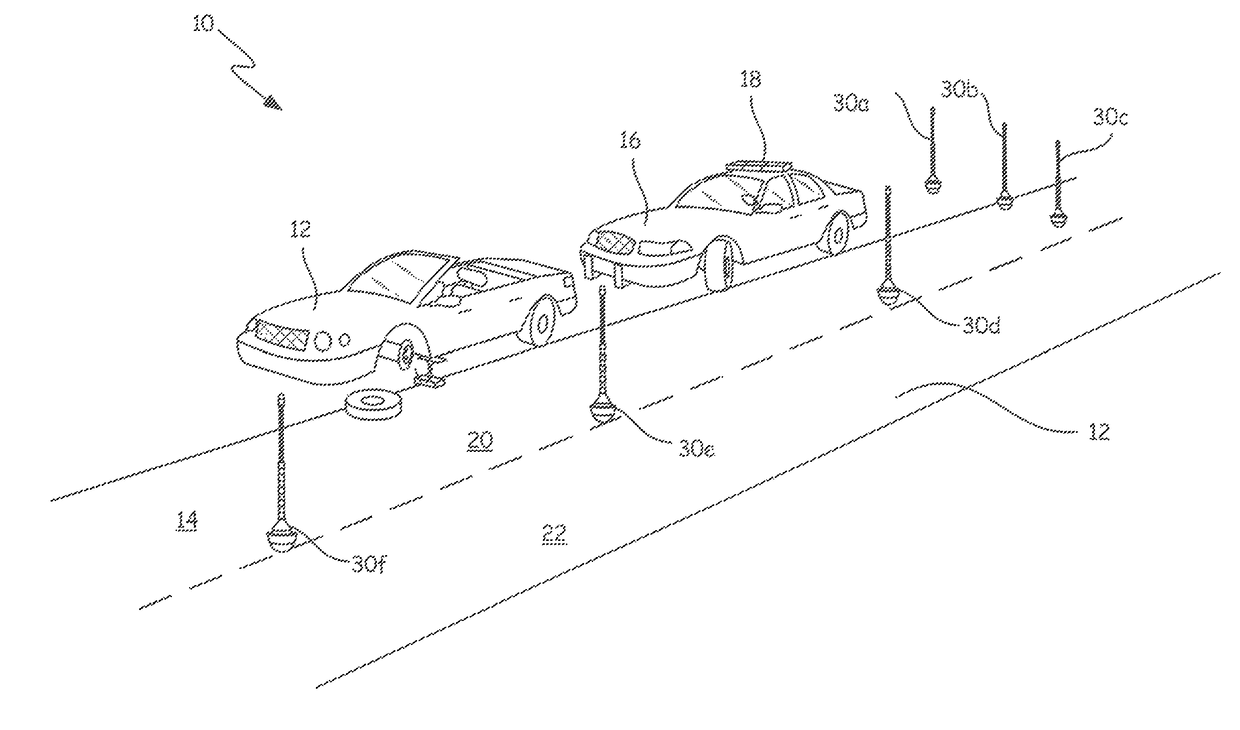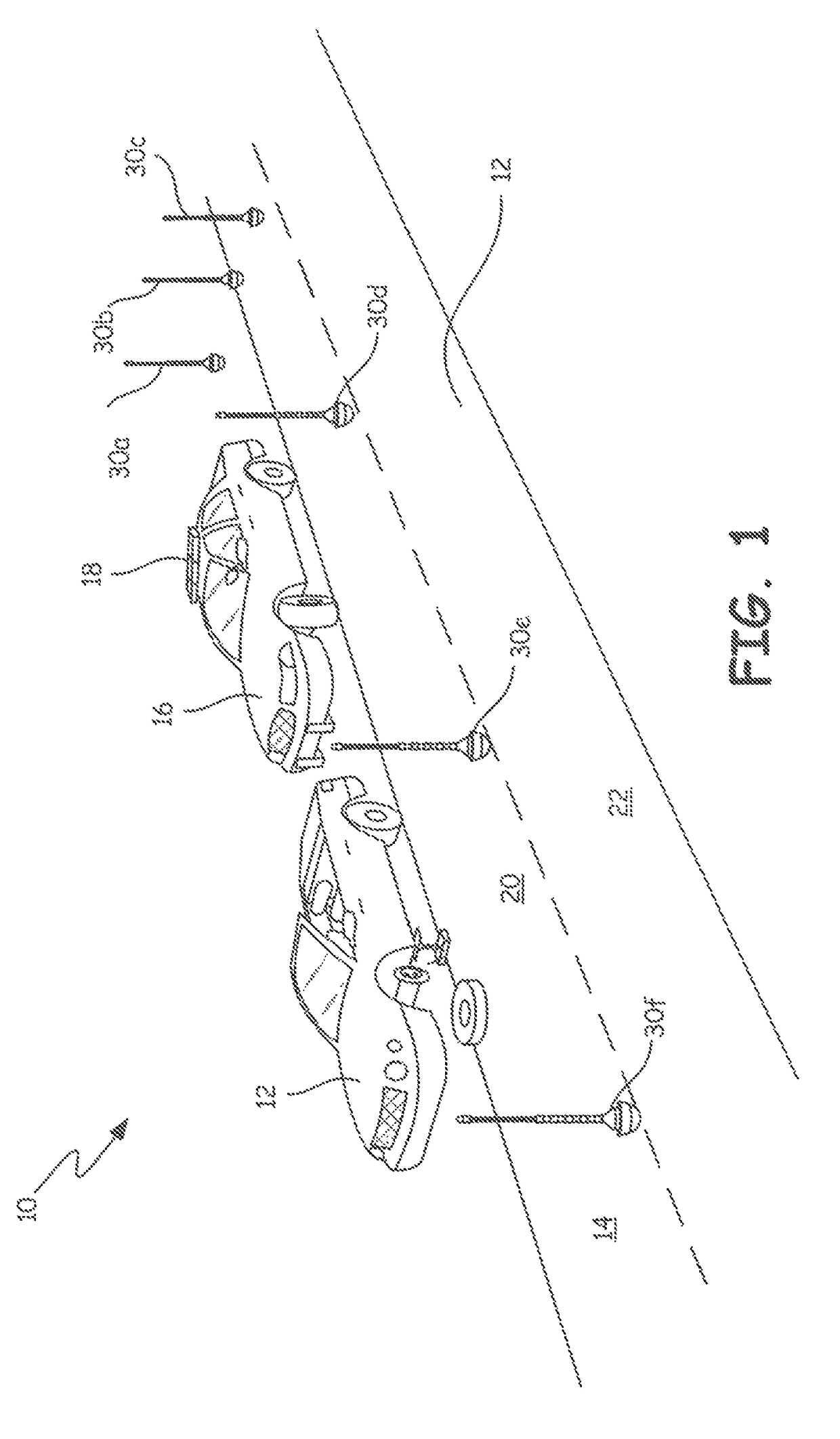Emergency safety marker systems
a technology of emergency safety and marker system, applied in the field of emergency safety marker system, can solve the problems of suffering the risk of being struck by an approaching motorist, and achieve the effects of avoiding personal injury, enhancing visibility, and enhancing visibility
- Summary
- Abstract
- Description
- Claims
- Application Information
AI Technical Summary
Benefits of technology
Problems solved by technology
Method used
Image
Examples
embodiment 160
[0115]A spring embodiment 160 for the actuator mechanism 54 is shown in FIG. 11. The structure of the stanchion tube 42 and carrier tube 48 are similar to the FIG. 9 embodiment. A compression spring 162 is disposed inside chamber 122 between the bottom wall of stanchion tube 42 and retaining member 164 disposed below the bottom surface of the carrier tube 48 containing the light array wand 44. An electronic solenoid operates actuator arm 166 connected to hook 168 which engages recess 170 formed in the bottom surface of retaining member 164.
[0116]When actuated, the low-impact sensor switch 54 / 86 closes its switch to send electrical current to the solenoid actuator 100. This solenoid actuator in turn causes the actuator arm 166 to move to disengage hook 168 from recess 170 in the retaining member 164. This allows the compression spring 162 to expand to its fully length, using its stored energy to push against the bottom surface of the light array wand to raise it inside stanchion tube...
embodiment 180
[0118]A jack screw embodiment 180 for the actuator mechanism 54 is shown in FIG. 12. The structure of the stanchion tube 42 and carrier tube 48 are similar to the FIG. 9 embodiment. A base support 182 is mounted to the bottom surface of the carrier tube 48 of the light array wand 44. A threaded column 184 contained inside chamber 122 is attached at its upper end to the base support 182. The bottom end of the threaded column 184 is operably secured to a motor 186 also contained inside chamber 122.
[0119]When actuated, the low-impact sensor switch 54 / 86 closes its switch to send electrical current to motor 186. The energized motor rotates threaded column 184 to raise base support 182 and with it the light array wand inside stanchion tube 42 to its extended position when lips 126 of the carrier tube abut shoulders 128 in stanchion tube. Release pin 138 supports the light array wand in its vertically extended position. Mating female and male contacts complete the electrical circuit to de...
embodiment 320
[0167]Also mounted to upper electronics housing 336 is on / off switch 370. The emergency responder can use this switch 370 to manually turn on and off lights bulbs338 contained in the hand-held safety marker 320. Unlike safety marker 30, this hand-held embodiment 320 of the safety marker device does not contain a low-impact sensor switch that is actuated when the safety marker is dropped on the ground or other hard surface. Instead, it must be manually turned on.
[0168]Also mounted to upper electronics housing 336 is screamer switch 372. This switch is used by the emergency responder to manually turn on and off the screamer module 366 that emits the emergency warning sound or message if an oncoming motorist strikes the safety marker 320 near the accident scene and actuates high-impact sensor witch 354.
[0169]Finally day / night switch 374 is mounted to upper electronics housing 336. LED bulbs 338 in particular need to be bright enough during daylight hours to be seen by oncoming motorist...
PUM
 Login to View More
Login to View More Abstract
Description
Claims
Application Information
 Login to View More
Login to View More - R&D
- Intellectual Property
- Life Sciences
- Materials
- Tech Scout
- Unparalleled Data Quality
- Higher Quality Content
- 60% Fewer Hallucinations
Browse by: Latest US Patents, China's latest patents, Technical Efficacy Thesaurus, Application Domain, Technology Topic, Popular Technical Reports.
© 2025 PatSnap. All rights reserved.Legal|Privacy policy|Modern Slavery Act Transparency Statement|Sitemap|About US| Contact US: help@patsnap.com



